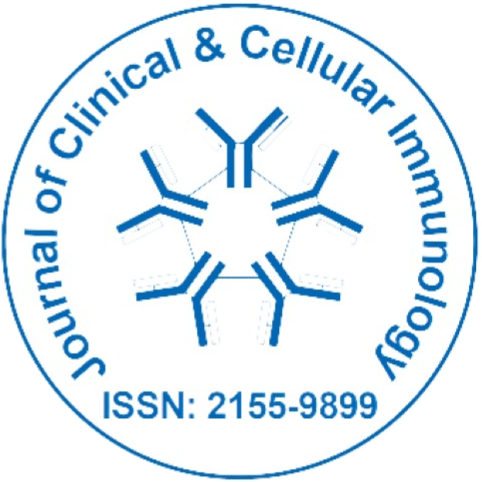
Journal of Clinical and Cellular Immunology
Open Access
ISSN: 2155-9899

ISSN: 2155-9899
Perspective - (2024)Volume 15, Issue 4
Inflammatory disorders are a complex and multifaceted group of conditions that affect millions of people worldwide. Characterized by an abnormal and excessive inflammatory response, these disorders can lead to significant morbidity and mortality if left untreated. Inflammation is a natural response to tissue damage or infection, but in inflammatory disorders, the immune system becomes overactive and causes damage to healthy tissues. This can result in a range of symptoms, including pain, swelling, redness and warmth, as well as impaired function and quality of life.
The pathophysiology of inflammatory disorders is complex and involves multiple cell types and signaling pathways. Activation of immune cells, such as T-cells and macrophages, leads to the production of pro-inflammatory cytokines and chemokines, which recruit additional immune cells to the site of inflammation. This can lead to a vicious cycle of inflammation and tissue damage, which can be difficult to treat.
In addition to the physical symptoms of inflammatory disorders, they can also have significant psychological and social impacts. Patients with chronic inflammatory disorders may experience depression, anxiety and social isolation, which can further Enhance their condition. Furthermore, inflammatory disorders can have significant economic impacts on individuals and society as a whole, due to lost productivity, healthcare costs and reduced quality of life.
In this study, it will provide an overview of the current understanding of inflammatory disorders, including their pathophysiology, clinical features and treatment options. It will also discuss the latest advances in the diagnosis and management of inflammatory disorders, including new therapies and lifestyle changes that can help patients manage their condition and improve their quality of life.
Pathophysiology of inflammatory disorders
Inflammatory disorders are characterized by an imbalance between the production of pro-inflammatory and anti-inflammatory cytokines. Pro-inflammatory cytokines, such as Tumor Necrosis Factor-alpha (TNF-alpha) and Interleukin-1 beta (IL-1β), promote inflammation and tissue damage, while anti-inflammatory cytokines, such as Interleukin-10 (IL-10) and Transforming Growth Factor-beta (TGF-β), suppress inflammation and promote tissue repair.
The development of inflammatory disorders is often driven by a combination of genetic and environmental factors, including genetic mutations, infections and environmental toxins. In some cases, inflammatory disorders may be triggered by autoimmune responses, where the immune system mistakenly attacks healthy tissues.
Clinical features of inflammatory disorders
Inflammatory disorders can manifest in a wide range of ways, depending on the specific disease and affected tissues. Common clinical features of inflammatory disorders include pain and swelling, redness and warmth, loss of function, fever and fatigue. Some examples of inflammatory disorders include:
• Rheumatoid arthritis a chronic autoimmune disorder that causes inflammation and stiffness in the joints
• Crohn's disease a chronic inflammatory bowel disease that causes inflammation and damage in the gastrointestinal tract
• Psoriasis a chronic skin condition that causes inflammation and scaling of the skin.
Treatment options for inflammatory disorders
The treatment of inflammatory disorders typically involves a combination of medications, lifestyle changes and alternative therapies. Medications, lifestyle changes and alternative therapies used to treat inflammatory disorders include:
• Corticosteroids which reduce inflammation and suppress the immune system
• Non-Steroidal Anti-Inflammatory Drugs (NSAIDs) which reduce inflammation and pain
• Biologics which target specific proteins involved in the inflammatory response.
Inflammatory disorders are a complex and multifaceted group of conditions that can have significant impacts on quality of life. While there is currently no cure for inflammatory disorders, there are many effective treatments available to manage symptoms symptoms and improve outcomes. By understanding the pathophysiology of inflammatory disorders, clinicians can develop targeted treatment plans that address the underlying causes of disease. Furthermore, lifestyle changes and alternative therapies can help patients manage their symptoms and improve their overall well-being.
Citation: Jones S (2024). Inflammatory Disorders: A Perspective of Current Understanding and Treatment Options. J Clin Cell Immunol. 15:726.
Received: 01-Jul-2024, Manuscript No. JCCI-24-33541; Editor assigned: 03-Jul-2024, Pre QC No. JCCI-24-33541 (PQ); Reviewed: 17-Jul-2024, QC No. JCCI-24-33541; Revised: 24-Jul-2024, Manuscript No. JCCI-24-33541 (R); Published: 31-Jul-2024 , DOI: 10.35248/2155-9899.24.15.726
Copyright: © 2024 Jones S. This is an open-access article distributed under the terms of the Creative Commons Attribution License, which permits unrestricted use, distribution, and reproduction in any medium, provided the original author and source are credited.